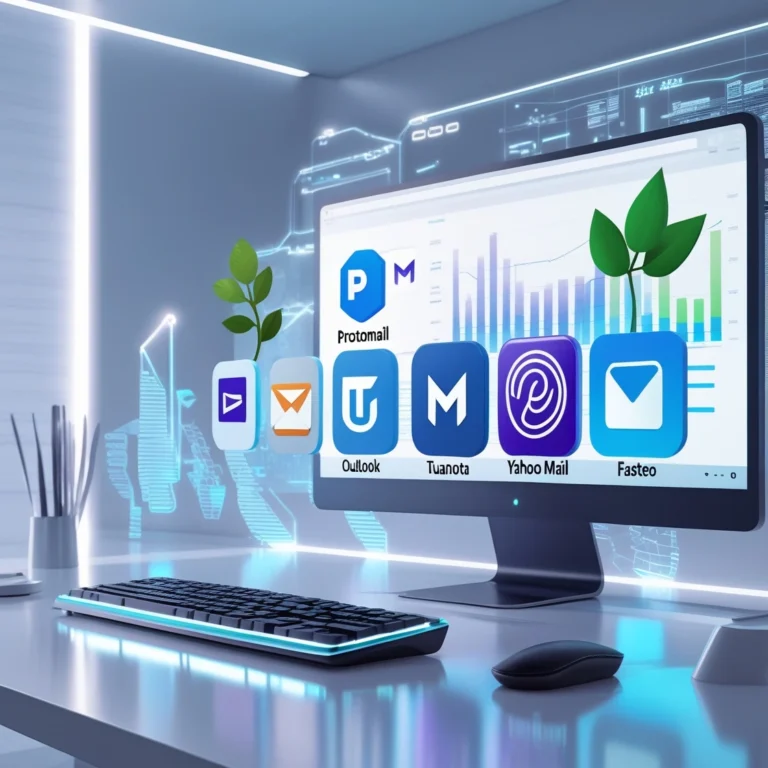Essential Digital Strategies for Business Growth 2025
Navigating the Future: Essential Digital Transformation Strategies for 2025 and Beyond
Estimated reading time: 8-9 minutes
Key Takeaways:
- Digital transformation is essential for businesses to thrive in 2025 and beyond, focusing on web, mobile, cloud, AI, and UI/UX.
- Next-generation web development (Next.js, React) and cross-platform mobile solutions (Flutter, React Native) are crucial for engaging user experiences and efficient development.
- Cloud computing (serverless, microservices) and DevOps (CI/CD automation) provide agile, scalable, and cost-efficient infrastructure.
- AI automation significantly boosts productivity by automating repetitive tasks, enhancing customer service via chatbots, and optimizing business processes.
- Strategic digital transformation involves assessing current states, setting clear goals, prioritizing high-impact areas, and fostering a culture of innovation, especially for small businesses.
Table of Contents
- The Evolving Digital Frontier: Web and Mobile Innovation Driving Engagement
- Cloud Computing and DevOps: Building Resilient and Agile Infrastructure
- AI Automation: The Engine of Modern Business Efficiency
- Strategic Digital Transformation: Actionable Steps for Growth
- Your Partner in Digital Transformation
- Frequently Asked Questions (FAQ)
The digital landscape is evolving at an unprecedented pace, with new technologies emerging daily that reshape how businesses operate, innovate, and connect with their customers. For any organization looking to thrive in this dynamic environment, embracing robust digital transformation strategies is no longer optional—it’s a fundamental imperative. From cutting-edge web development to intelligent AI automation, understanding and leveraging these shifts will define market leaders in 2025 and beyond.
This guide, drawing insights from the latest tech trends and expert analyses, breaks down the core pillars of modern digital transformation. We’ll explore how web development, mobile innovation, cloud computing, AI automation, and refined UI/UX design are converging to create powerful opportunities for businesses of all sizes.
The Evolving Digital Frontier: Web and Mobile Innovation Driving Engagement
In the digital realm, your online presence is often the first, and most crucial, point of contact with your audience. As we approach 2025, the demand for fast, intuitive, and highly engaging digital experiences is higher than ever. This requires a sophisticated approach to both web and mobile development, focusing on performance, user experience, and future-proof architectures.
Next-Generation Web Development: Speed, Agility, and User Experience
The days of slow, clunky websites are over. Modern users expect instant loading times, seamless navigation, and interactive experiences. This is where frameworks like Next.js and React shine, offering significant advantages for building high-performance web applications.
- Next.js for Small Businesses: For startups and small enterprises, building a fast marketing site in one weekend with Next.js is not just a dream, but a tangible reality. Its server-side rendering and static site generation capabilities dramatically improve initial page load, which is critical for SEO and user retention. This efficiency allows small businesses to establish a robust online presence quickly without extensive development overhead.
- React Performance Fixes: Beyond the framework choice, optimizing React applications is key. Simple yet powerful techniques, such as lazy loading components, memoization, virtualizing long lists, and optimizing image delivery, can reduce page load times by seconds. These performance optimization techniques translate directly into better user engagement, lower bounce rates, and improved conversion rates. Imagine a client’s page load time cut by 60%—this real-world case study exemplifies the impact of focused optimization.
- Headless CMS and WordPress: For content-rich sites, the traditional WordPress setup can sometimes become bloated. Embracing a headless CMS architecture with WordPress allows businesses to leverage WordPress’s familiar content management capabilities while serving content via a modern frontend like Next.js. This separation of concerns results in a faster, more secure, and scalable website, free from the “bloat” of unnecessary plugins that can hinder SEO and performance.
The Mobile Revolution Continues: Cross-Platform Excellence
Mobile applications are indispensable for reaching customers on the go. The debate between native development and cross-platform solutions continues, with frameworks like Flutter and React Native leading the charge.
- Flutter vs React Native in 2025: Both Flutter and React Native offer compelling advantages for building cross-platform apps from a single codebase, significantly reducing development time and cost compared to maintaining separate iOS and Android teams.
- Flutter, backed by Google, offers exceptional performance and highly customizable UI, enabling developers to build simple cross-platform apps from idea to Play Store with relative ease. Its “build once, deploy anywhere” philosophy extends beyond mobile to web and desktop, making it incredibly versatile for companies prioritizing consistent UI across platforms.
- React Native, leveraging JavaScript, has a vast community and allows developers to use their existing web development skills to create mobile apps. For businesses already invested in the React ecosystem for their web presence, React Native offers a smoother transition and shared codebase benefits.
The choice often boils down to team expertise, specific performance needs, and desired UI fidelity. For startups, either framework can accelerate market entry, providing an agile path to a minimum viable product (MVP).
Modern UI/UX Design: Beyond Aesthetics
A great user interface (UI) and user experience (UX) are not just about pretty designs; they are about intuitive interactions, accessibility, and driving desired user behaviors. Modern UI/UX design emphasizes:
- Responsive UI Design: Ensuring your application looks and functions flawlessly across all devices—desktops, tablets, and smartphones—is paramount.
- Accessibility: Designing accessible buttons and user interfaces is critical for inclusivity, ensuring that individuals with disabilities can effectively interact with your digital products. Tools like Figma offer features that can guide non-designers in creating more accessible components.
- Intuitive Journeys: Streamlining user flows, reducing cognitive load, and providing clear feedback loops are central to a positive UX, directly impacting user satisfaction and conversion rates.
AI TechScope’s Role: We specialize in custom website development and mobile app solutions that prioritize performance, engaging UI/UX, and scalability. Our expertise in Next.js, React, and leading mobile frameworks ensures your digital presence is not just current, but future-ready, driving business efficiency and competitive advantage.
Cloud Computing and DevOps: Building Resilient and Agile Infrastructure
Beneath the sleek interfaces and powerful applications lies a robust infrastructure—the backbone of any successful digital transformation. Cloud computing and DevOps practices are revolutionizing how businesses deploy, manage, and scale their applications, providing unparalleled agility and cost efficiency.
Strategic Cloud Migration and Serverless Architectures
Moving to the cloud is a critical step for many businesses, but it doesn’t have to be a daunting task.
- Cloud Migration Strategy: “How to Move Your Legacy App to the Cloud Without Breaking It” highlights the importance of a phased, strategic approach. This often involves containerization (e.g., Docker), re-platforming, or even re-architecting components, allowing businesses to gradually shift existing applications to scalable cloud environments like AWS, Azure, or Google Cloud. The benefits include reduced operational costs, enhanced scalability, and improved disaster recovery.
- Serverless on AWS: For new applications and microservices, serverless architecture offers a compelling model. By abstracting away server management, developers can focus purely on code, while cloud providers automatically handle scaling, patching, and provisioning. Creating a cost-efficient backend that scales automatically with AWS Lambda, API Gateway, and other serverless services can dramatically reduce infrastructure overhead and operational complexity, making it ideal for startups and projects with fluctuating loads.
- Microservices Architecture: While the article “Micro Frontends: When They Help and When They Hurt” focuses on the frontend, its principles extend to microservices. Breaking down large monolithic applications into smaller, independent, and loosely coupled services allows for greater development agility, easier maintenance, and improved fault isolation. This architectural shift supports faster innovation and more resilient systems, crucial for enterprise digital adoption.
DevOps Best Practices and CI/CD Automation
To truly harness the power of cloud and microservices, robust DevOps practices are essential. DevOps bridges the gap between development and operations, fostering collaboration and automating crucial processes.
- CI/CD for Small Teams: Continuous Integration and Continuous Deployment (CI/CD) automation ensures that code changes are frequently integrated, tested, and deployed to production. For small teams, automated deployments without the headache are achievable using tools like GitHub Actions. A GitHub Actions deploy tutorial can guide teams through setting up automated workflows that trigger builds, tests, and deployments upon code commits, dramatically accelerating the release cycle and improving code quality. This CI/CD automation reduces manual errors, frees up developer time, and allows for more frequent, smaller releases, which are inherently less risky.
- Tech Stack for Modern Businesses: A modern tech stack integrates these elements: cloud services for infrastructure, containerization for deployment consistency, CI/CD pipelines for automation, and monitoring tools for operational insights. This holistic approach ensures applications are not only performant but also secure, reliable, and continuously evolving.
AI TechScope’s Role: We provide expert AI consulting and development services, guiding businesses through complex cloud migrations, implementing serverless architectures, and establishing robust DevOps pipelines. Our focus on CI/CD automation ensures your development process is streamlined, efficient, and cost-effective, translating into workflow optimization and faster time-to-market.
AI Automation: The Engine of Modern Business Efficiency
Artificial intelligence (AI) is no longer a futuristic concept; it’s a practical, powerful tool transforming business operations today. From automating repetitive tasks to providing intelligent insights, AI automation for businesses is a cornerstone of modern digital transformation strategies.
Leveraging AI for Enhanced Productivity and Customer Engagement
- Automate Repetitive Tasks with No-Code Tools + AI: One of the most immediate benefits of AI is its ability to automate mundane, time-consuming tasks. Businesses can save 5–10 hours per week by implementing no-code tools combined with AI. This can include automating data entry, report generation, email categorization, and even scheduling. Such automation frees up employees to focus on higher-value, strategic work, significantly boosting overall productivity and reducing operational costs.
- AI-Powered Web Apps and SaaS Product Optimization: Integrating AI features directly into web applications and SaaS products can delight users and create significant competitive advantages. Simple yet impactful AI features can include personalized recommendations, smart search functionalities, predictive analytics, and automated content generation. Making your SaaS smarter doesn’t always require massive investment; sometimes, it’s about identifying low-effort AI features that deliver high user value.
- Chatbot Automation for Customer Service: AI chatbots are revolutionizing customer service, offering instant support and improving customer satisfaction. Small businesses, in particular, can use chatbots to save time, providing real workflows that work. They can handle frequently asked questions, qualify leads, provide product information, and even guide users through troubleshooting steps, available 24/7. This not only enhances customer experience but also significantly reduces the workload on human support teams.
- Enterprise Digital Adoption: For larger enterprises, AI plays a crucial role in streamlining complex internal processes, from HR to supply chain management. AI-driven analytics can identify bottlenecks, predict demand, and optimize resource allocation, leading to profound operational efficiencies and competitive advantage.
AI TechScope’s Role: AI TechScope is a leading provider of virtual assistant services, specializing in AI-powered automation and n8n workflow development. We help businesses leverage cutting-edge AI tools and technologies to scale operations, reduce costs, and improve efficiency through intelligent delegation and automation solutions. Our AI consulting services identify opportunities for integrating AI, from enhancing customer service with chatbots to optimizing internal workflows, driving profound workflow optimization and digital transformation.
Strategic Digital Transformation: Actionable Steps for Growth
Embarking on a journey of digital transformation strategies can seem overwhelming, especially for small businesses or those with limited budgets. However, it’s a journey best taken in phases, focusing on high-impact areas first.
Digital Transformation on a Budget: Seven Steps to Start Today
- Assess Your Current State: Understand your existing processes, technologies, and pain points. Where are the inefficiencies? What outdated systems are holding you back?
- Define Clear Goals: What do you want to achieve? Improved customer experience? Reduced operational costs? Faster market entry? Specific goals will guide your strategy.
- Prioritize High-Impact Areas: Start with areas where digital tools can provide the quickest and most significant returns, such as automating repetitive tasks or improving your online presence.
- Embrace Cloud Solutions: Leverage the scalability and cost-efficiency of cloud services for infrastructure and applications.
- Adopt Agile Methodologies: Implement iterative development and deployment cycles (like CI/CD) to ensure continuous improvement and faster adaptation.
- Invest in Data Literacy and Analytics: Use data to make informed decisions, track performance, and identify new opportunities.
- Foster a Culture of Innovation: Encourage your team to experiment with new tools and ideas, promoting continuous learning and adaptation.
For small businesses, in particular, tech innovation for small businesses is about smart, targeted investments rather than massive overhauls. It’s about finding practical ways to use technologies like Next.js for a fast marketing site, chatbots for customer service, or no-code AI tools for automation. These incremental changes accumulate into significant competitive advantages over time.
Your Partner in Digital Transformation
The landscape of 2025 technologies—from web and mobile innovation to cloud, DevOps, and AI automation—presents a myriad of opportunities for businesses ready to embrace change. These trends are not isolated; they are interconnected pillars that, when strategically combined, drive unparalleled business efficiency, accelerate digital transformation, and establish a clear competitive advantage.
At AI TechScope, we are your dedicated partners in navigating this complex yet rewarding journey. We empower businesses to leverage these cutting-edge AI tools and technologies, scale operations, reduce costs, and improve efficiency through:
- AI Automation: Implementing intelligent systems to streamline your workflows.
- n8n Workflow Automation: Building robust, interconnected automation flows tailored to your specific needs.
- AI Consulting: Guiding your strategy, identifying opportunities, and integrating AI into your core business processes.
- Custom Website Development: Crafting high-performance, engaging digital platforms designed for your success.
Don’t let the future of technology pass you by. It’s time to transform challenges into opportunities.
Ready to accelerate your growth and unlock new efficiencies? Explore AI TechScope’s AI automation and consulting services today, and let us help you chart a course for unparalleled success in the digital era.
Frequently Asked Questions (FAQ)
What are the key pillars of modern digital transformation?
The core pillars of modern digital transformation include web development, mobile innovation, cloud computing, AI automation, and refined UI/UX design. These areas converge to create powerful opportunities for businesses to operate more efficiently, innovate faster, and better connect with customers.
How can small businesses benefit from Next.js?
Small businesses can significantly benefit from Next.js by quickly building fast marketing sites. Its server-side rendering and static site generation capabilities improve page load times, which are crucial for SEO and user retention, allowing businesses to establish a robust online presence efficiently without extensive development overhead.
What are the advantages of Flutter and React Native for mobile app development?
Both Flutter and React Native allow businesses to build cross-platform apps from a single codebase, reducing development time and cost. Flutter offers exceptional performance and customizable UI, ideal for consistent UI across platforms. React Native, leveraging JavaScript, has a vast community and allows developers to use existing web skills, offering a smoother transition for businesses already in the React ecosystem.
How does AI automation contribute to business efficiency?
AI automation boosts business efficiency by automating repetitive tasks, saving employees significant time. It enhances customer service through chatbots, provides intelligent insights for decision-making, and optimizes internal workflows, leading to reduced operational costs, increased productivity, and competitive advantages.
What are some actionable steps for starting digital transformation on a budget?
On a budget, businesses should start by assessing their current state, defining clear goals, and prioritizing high-impact areas where digital tools offer quick returns. Embracing cloud solutions, adopting agile methodologies, investing in data literacy, and fostering a culture of innovation are also critical steps for effective digital transformation.







